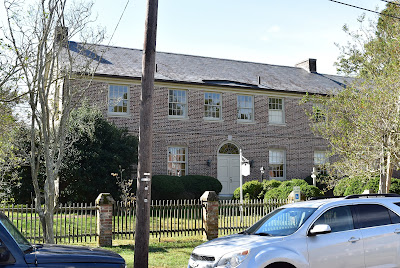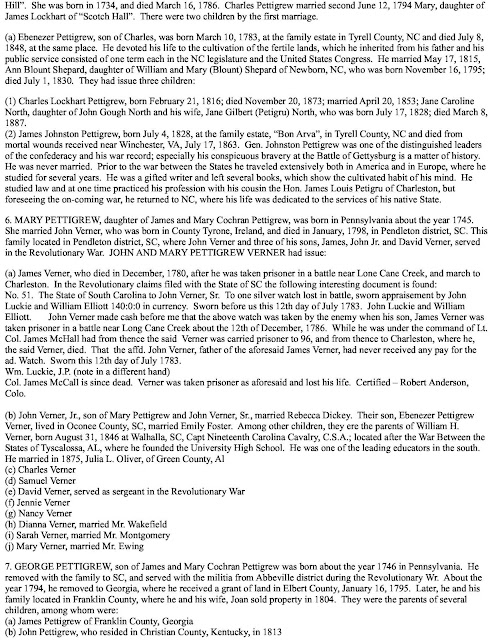The progenitors of the southern Pettigrews are James Pettigrew III and Mary Cochran who immigrated to the USA (Pennsylvania) from Northern Ireland about 1740. The home in Ireland where James grew up is still standing. See Crilly House here. The story told most frequently is that James was Protestant and Mary was Catholic. This union formed a problem with their respective families and they left Northern Ireland for America where they could live outside the Protestant-Catholic "problem".
Will of James Pettigrew III, Abbeville District, SC, 1784
The descendants of James and Mary moved into North Carolina, South Carolina and Alabama and the Pettigrew name is noteworthy in the history of those states. Because this family made an imprint in these states, there is a bounty of information available online, at state archives, local libraries and universities. I have provided a few links at the bottom of the page if one is interested in obtaining more details about this family. I will only provide some highlights of my research here. My line is through Mary Pettigrew, the daughter of James Pettigrew III and Mary Cochran. Mary Pettigrew married John Verner and they moved to the western part of South Carolina along the Tugaloo River. My maternal grandparents are both descendants of James Pettigrew III and Mary Cochran.
(Internet photo; Owner unknown)
(Photo: Wikipedia)
As you wish to know something of the origin of your family, I will give you as good an account as I can. My great-grandfather (James Petigru, b. Abt. 1613) left France for the sake of his religion in the time of King Louis XIV, and was an officer in Cromwell's Army. He had two sons, John and James (b. Abt. 1659). As to John, we have very little account given of him. James Pettigrew I (b. Abt. 1659, SCOTLAND) married Martha Moore, a Scotch lady. He settled in Ireland and was an officer in King William's army at the Battle of the Boyne (1690). He was given a tract of land of 300 acres in County Tyrone on what was called the Blackwater where he lived and died. 7 sons and 2 daughters: William, James (my father), Robert, Charles, John, Samuel. One died young. William was the eldest. He had three sons. His oldest son, James, held a Captain's commission, was with Howe at the Battle of Brandywine, and was badly wounded. Robert, the third son, was a Doctor of Physics, and said to be eminent. Charles never married. John had a large family. Samuel got a Captain's commission, was at Gibraltar and died there. My father, James Pettigrew II, had a classical education, but never went to college. In his 18th or 19th year, he married Mary Cochran, the daughter of Capt. George Cochran who lived at a place called the Grange. After having four children, he left all of his friends and came to American in November 1741. He landed at New Castle. His oldest child was a daughter named Rachel after her grandmother with whom she stayed. My father became acquainted with Dr. Franklin, who wished him to study physics, which he declined, but got a tract of 300 acres on March Creek in Pennsylvania where he lived until he was broken up by the War of 1755. Shortly after Braddock's defeat, he sold his land for 80 pounds and removed into Virginia to Lunenburg Old Court House, and rented a piece of land. There I was born in 1758 (26 Feb 1758). After staying there three or four years we removed into Granville Co, NC, bought 300 acres of land from Mr. Howell Lewis. Before he left Pennsylvania, he sent for his daughter Rachel, but she died at sea. His next oldest child, Martha, married a Mr. John Witherspoon. She had a large family. Likewise his son, John, married Sarah Matthews. Mary, his third daughter, who is now alive, married a Mr. John Verner. These were all married before we left Virginia. When he came to North Carolina, he had James, Charles, George, Ebenezer, William, Jane, Elizabeth and Nancy. These were all single. James went to the (illegible in copy), Charles to school. The rest of us stayed at home. Hearing a good account of Long Cane (Abbeville District, SC), my father sold out, and set out in the latter end of October 1768 for South Carolina, where we landed after three weeks traveling. Jane, about this time, married Stephen Tilly. Charles had a school in Edenton so that our family was but small. We settled on what was called Jews' land, about 6 or 7 miles above Abbeville Court House. We lived there until 1775 when we removed to land bought of John Du upon Little River, now in the possession of Peter Brown. Our land being good, we made good crops, our stock increased very fast, and my father and mother enjoyed themselves quite comfortably until the war commenced, which did affect us until the Indians broke out on 1st of July 1776. The alarm was great. Capt. Smith and family, all but two sons, were killed. The whole country was in a great bustle to get a place of safety which we found at Mr. James Noble's fort, commanded by Patrick Calhoun, Esq. As the family did not stay long in the fort, they soon got home. I was taken to camp. Everything went on very well and better than we had the right to expect until the year 1779. James Pettigrew, the son of John, better known as "Long Jim", brought up the camp fever from Stono. My father had him brought to him home where he lay 2 or 3 weeks, but at last recovered. My youngest sister, Nancy, was taken with the same kind of fever. I was obliged to join camp on the 8th of August. She was ill at the time, but we did not think in great dancer, not March until the 11th, then we set out for the middle ground between the Cherokee and Creek Indians. When I was about 100 miles out from the habitation, I was overtaken by Gen., Anderson who told me my sister died the very day we marched from our encampment on the Lower Dam?? in Georgia. I wished to turn back, but Gen. Pickens would not hear of it. I wore four solitary weeks before my return. The last day and night I rode about 61 miles, still in hopes the news might not be true, but I found it much worse than I had heard, for my other sister, Elizabeth, lay at the point of death, and died the day after my arrival, 15th September. This was a serious shock to the family as there was no white person left with my parents but myself. But I have dwelt long enough on the distressing. I will now give a short account of the other side of the family. My grandfather, George Cochran, was married to Rachel Higginbotham. He had 2 sons and 2 daughters. His oldest son, Robert, died young with the small pox. William lived to be old, enjoyed a small post under the government, but was not happy in his marriage. My great-grandfather, Robert Cochran, is mentioned in the history of those times. He was a Captain of Dragoons, was in the memorable siege of Derry (1689) where they all like to have died of famine before they got relief. It is recorded of him that he went through the body of King James' Army, sword in hand, after his horse was shot under him, and he shot through the leg, and that he killed two French generals though he always said he killed only one, Gen. M???. He was a good soldier, there is no doubt. My grandfathers on both sides were old. One had 94, the other 96 marked on his tombstone. I have given you a small sketch of your ancestors which may be an amusement in a vacant hour, and I hope you will always conduct yourself in such a manner that it will be a pleasure to some friend to write your history, and I wish it may be handed down to posterity. |
- I do not know if the organization is still in existence, but there used to be a publication called "The Pettigrew Family Quarterly" that was published four times a year. Check www.familysearch.com and the Abbeville and Greenwood (SC) libraries for this publication.
- The University of North Carolina has quite a bit of Pettigrew information - visit link
- A digital download of the books The Pettigrew Papers, Vol 1 & 2, written by Sarah McCulloh Lemmon, over 1500s pages of Pettigrew family research can be obtained here - visit link.
- James Louis Petigru: Southern Conservative, Southern Dissenter by William and Jane Pease - visit link.
- The Making of McCormick County by Bobby F. Edmonds
















.jpg)








